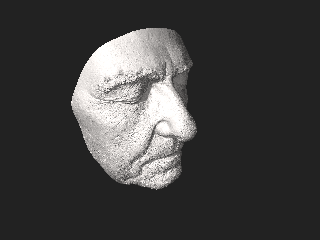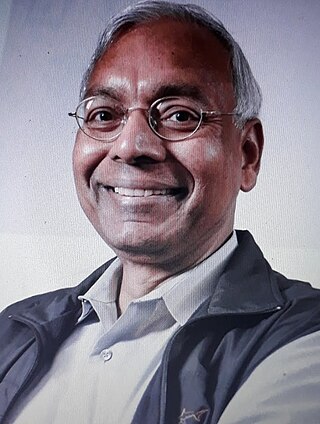Pattern recognition is the automated recognition of patterns and regularities in data. It has applications in statistical data analysis, signal processing, image analysis, information retrieval, bioinformatics, data compression, computer graphics and machine learning. Pattern recognition has its origins in statistics and engineering; some modern approaches to pattern recognition include the use of machine learning, due to the increased availability of big data and a new abundance of processing power. These activities can be viewed as two facets of the same field of application, and they have undergone substantial development over the past few decades.
Robert M. Haralick is Distinguished Professor in Computer Science at Graduate Center of the City University of New York (CUNY). Haralick is one of the leading figures in computer vision, pattern recognition, and image analysis. He is a Fellow of the Institute of Electrical and Electronics Engineers (IEEE) and a Fellow and past president of the International Association for Pattern Recognition. Prof. Haralick is the King-Sun Fu Prize winner of 2016, "for contributions in image analysis, including remote sensing, texture analysis, mathematical morphology, consistent labeling, and system performance evaluation".

Three-dimensional face recognition is a modality of facial recognition methods in which the three-dimensional geometry of the human face is used. It has been shown that 3D face recognition methods can achieve significantly higher accuracy than their 2D counterparts, rivaling fingerprint recognition.

Thomas Shi-Tao Huang was a Chinese-born American computer scientist, electrical engineer, and writer. He was a researcher and professor emeritus at the University of Illinois at Urbana-Champaign (UIUC). Huang was one of the leading figures in computer vision, pattern recognition and human computer interaction.
King-Sun Fu was a Chinese-born American computer scientist. He was a Goss Distinguished Professor at Purdue University School of Electrical and Computer Engineering in West Lafayette, Indiana. He was instrumental in the founding of International Association for Pattern Recognition (IAPR), served as its first president, and is widely recognized for his extensive contributions to- and a pioneer in- the field of pattern recognition and machine intelligence. In honor of the memory of Professor King-Sun Fu, IAPR gives the biennial King-Sun Fu Prize to a living person in the recognition of an outstanding technical contribution to the field of pattern recognition. The first King-Sun Fu Prize was presented in 1988, to Azriel Rosenfeld.

Linda G. Shapiro is a professor in the Department of Computer Science and Engineering, a Professor of Electrical Engineering, and Adjunct Professor of Biomedical Informatics and Medical Education at the University of Washington.

Mean shift is a non-parametric feature-space mathematical analysis technique for locating the maxima of a density function, a so-called mode-seeking algorithm. Application domains include cluster analysis in computer vision and image processing.
In computer vision, the bag-of-words model sometimes called bag-of-visual-words model can be applied to image classification or retrieval, by treating image features as words. In document classification, a bag of words is a sparse vector of occurrence counts of words; that is, a sparse histogram over the vocabulary. In computer vision, a bag of visual words is a vector of occurrence counts of a vocabulary of local image features.
In machine learning the random subspace method, also called attribute bagging or feature bagging, is an ensemble learning method that attempts to reduce the correlation between estimators in an ensemble by training them on random samples of features instead of the entire feature set.
Matti Kalevi Pietikäinen is a computer scientist. He is currently Professor (emer.) in the Center for Machine Vision and Signal Analysis, University of Oulu, Finland. His research interests are in texture-based computer vision, face analysis, affective computing, biometrics, and vision-based perceptual interfaces. He was Director of the Center for Machine Vision Research, and Scientific Director of Infotech Oulu.

Stuart Alan Geman is an American mathematician, known for influential contributions to computer vision, statistics, probability theory, machine learning, and the neurosciences. He and his brother, Donald Geman, are well known for proposing the Gibbs sampler, and for the first proof of convergence of the simulated annealing algorithm.

Anil Kumar Jain is an Indian-American computer scientist and University Distinguished Professor in the Department of Computer Science & Engineering at Michigan State University, known for his contributions in the fields of pattern recognition, computer vision and biometric recognition. Based on his Google Scholar profile, he has an h-index of 204, which is the highest among computer scientists identified in a survey published by UCLA.

Theodosios Pavlidis is a computer scientist and Distinguished Professor Emeritus of Computer Science at the State University of New York, Stony Brook.
Edwin Hancock (FREng) is a British computer scientist at the University of York specialising in computer vision and pattern recognition.

René Vidal is a Chilean electrical engineer and computer scientist who is known for his research in machine learning, computer vision, medical image computing, robotics, and control theory. He is the Herschel L. Seder Professor of the Johns Hopkins Department of Biomedical Engineering, and the founding director of the Mathematical Institute for Data Science (MINDS).
Tin Kam Ho is a computer scientist at IBM Research with contributions to machine learning, data mining, and classification. Ho is noted for introducing random decision forests in 1995, and for her pioneering work in ensemble learning and data complexity analysis. She is an IEEE fellow and IAPR fellow.
Jiebo Luo is a Chinese-American computer scientist, Professor of Computer Science at the University of Rochester and Distinguished Researcher with Goergen Institute for Data Science. He is interested in artificial intelligence, data science and computer vision.
Bernt Schiele is a German computer scientist. He is Max Planck Director at the Max Planck Institute for Informatics and professor at Saarland University. He is known for his work in the field of computer vision and perceptual computing.

Josiane Zerubia is a French research scientist. She is the Director of Research at INRIA (DR1), Université Côte d'Azur. Dr. Zerubia has made pioneering research contributions. She has been the Principal Investigator of numerous projects like of the Ayin (2012-2016), the Ariana (1998-2011) and of the Pastis (1995-1997). Presently, she is leading as head of the Ayana exploratory project (2020-2023). She has been professor (PR1) at SUPAERO (ISAE) in Toulouse since 1999.

Mário A. T. Figueiredo is a Portuguese engineer, academic, and researcher. He is an IST Distinguished Professor and holds the Feedzai chair of machine learning at IST, University of Lisbon.
















